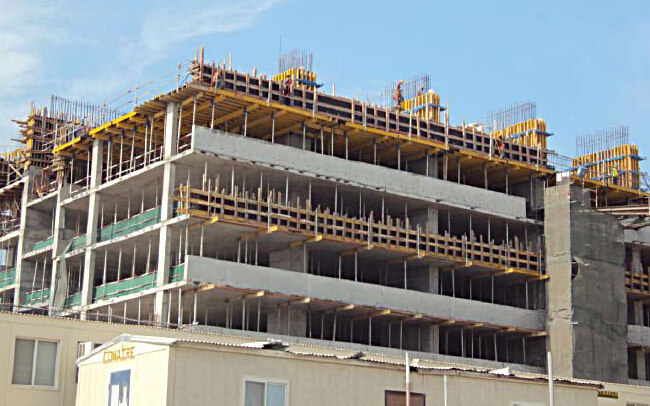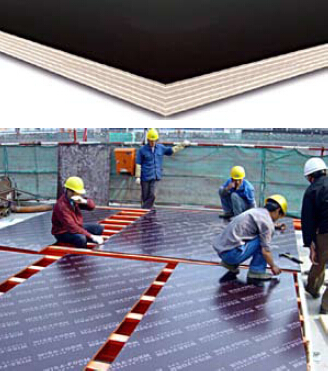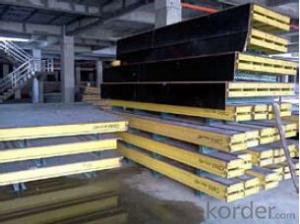Plywood Formwork systems for Formwork and Scaffolding
- Loading Port:
- Tianjin
- Payment Terms:
- TT OR LC
- Min Order Qty:
- 50 m²
- Supply Capability:
- 1000 m²/month
OKorder Service Pledge
Quality Product, Order Online Tracking, Timely Delivery
OKorder Financial Service
Credit Rating, Credit Services, Credit Purchasing
You Might Also Like
Plywood --- make perfect concrete surface
WISA-Form Birch is a coated special plywood using in the formwork systems where high
requirements are set on the concrete surface and the times of reuses.
With CNBM timber beam & WISA plywood, the formwork is low weight but high load capacity, it is
widely used in construction.
Characteristics:
◆ Component with high standardization.
◆ Assembling in site, flexible application.
◆ Light weight, easy transportation and storage.


- Q:How does steel formwork affect the overall architectural aesthetics of the structure?
- The overall architectural aesthetics of a structure can be significantly impacted by steel formwork. When steel is used as a material for formwork, it can give the building a sleek and modern appearance. Its smooth and rigid surface allows for precise and clean lines, resulting in a more refined and elegant look. Steel formwork also provides great flexibility in terms of design possibilities. It can be easily shaped and molded into complex and intricate patterns, allowing architects to create unique and visually appealing structures. This versatility opens up a wide range of architectural possibilities and enables the creation of buildings with distinct and eye-catching features. Furthermore, steel formwork offers a high level of structural stability, which enhances the overall aesthetics of the structure. The use of steel ensures that the formwork remains strong and sturdy, even under heavy loads. This is crucial for creating large and imposing architectural designs. The ability to use steel formwork in such constructions allows architects to achieve bold and impressive architectural forms that might not be possible with other materials. In addition to its visual impact, steel formwork also offers practical advantages. It is a durable and long-lasting material that can withstand harsh weather conditions, making it suitable for both indoor and outdoor applications. Steel formwork is also highly resistant to fire, corrosion, and pests, further ensuring the longevity and integrity of the structure. Overall, steel formwork plays a crucial role in shaping the architectural aesthetics of a structure. Its smooth surface, flexibility in design, structural stability, and durability contribute to creating visually appealing and iconic buildings. By choosing steel formwork, architects can achieve both functional and aesthetic goals, resulting in structures that are not only beautiful but also reliable and long-lasting.
- Q:Can steel formwork be used for underground parking structures?
- Yes, steel formwork can be used for underground parking structures. Steel formwork offers several advantages such as strength, durability, and the ability to withstand the pressure exerted by the surrounding soil. It provides a stable framework for pouring concrete and allows for quick and efficient construction of underground parking structures.
- Q:Is steel formwork suitable for high-rise construction?
- High-rise construction can indeed utilize steel formwork, which offers numerous advantages. Firstly, steel formwork possesses exceptional strength and durability, enabling it to withstand the immense pressures and loads associated with tall building construction. This feature ensures the safety and stability of the structure throughout the construction process. Secondly, steel formwork boasts exceptional versatility, allowing for easy customization to meet the specific requirements of high-rise construction. It can be designed and fabricated into various shapes and sizes, providing flexibility in creating different structural elements like walls, columns, and slabs. This adaptability facilitates efficient construction and minimizes the need for extensive modifications or adjustments. Moreover, the reusability of steel formwork makes it a cost-effective option for high-rise construction projects. By eliminating the constant need for new formwork materials, the overall construction costs are reduced. This sustainability aspect also contributes to minimizing waste and promoting resource efficiency. Furthermore, steel formwork ensures high-quality construction for high-rise buildings through its ability to provide a smooth and even surface finish. This characteristic eliminates the requirement for extensive plastering or finishing works, saving time and resources during the construction process. In conclusion, steel formwork is an excellent choice for high-rise construction due to its strength, versatility, reusability, and ability to provide a smooth finish. These qualities make it an ideal option for efficiently and effectively constructing tall buildings.
- Q:Can steel formwork be used for both interior and exterior concrete elements?
- Yes, steel formwork can be used for both interior and exterior concrete elements. Steel formwork is highly versatile and can be used in various construction applications. It is durable, strong, and capable of withstanding the pressure exerted by the wet concrete. Additionally, steel formwork offers excellent dimensional accuracy and can create smooth and uniform concrete surfaces. Whether it is for interior slabs, walls, or exterior foundations, columns, or beams, steel formwork is a reliable choice that can be used for both interior and exterior concrete elements.
- Q:What are the common safety certifications for steel formwork systems?
- There are several common safety certifications for steel formwork systems that ensure the highest standards of safety and quality. Some of the most recognized certifications include: 1. ISO 9001: This certification ensures that the manufacturer of the steel formwork system follows a quality management system that meets international standards. It focuses on customer satisfaction, continuous improvement, and adherence to regulatory requirements. 2. OHSAS 18001: This certification is specific to occupational health and safety management systems. It demonstrates that the manufacturer has implemented effective safety policies, procedures, and controls to prevent work-related injuries and illnesses. 3. CE Marking: This certification is a mandatory requirement for steel formwork systems sold in the European Union (EU). It indicates that the product meets the essential health, safety, and environmental protection requirements set by EU legislation. 4. ANSI/ASSE A10.9: This American National Standards Institute (ANSI) standard provides guidelines for the design, use, and maintenance of formwork systems, including steel formwork. Compliance with this standard ensures that the system is safe and suitable for use in construction projects. 5. UL Certification: Underwriters Laboratories (UL) is a globally recognized safety certification organization. UL Certification for steel formwork systems signifies that the product has been tested and meets specific safety standards. It is important to note that the specific safety certifications required may vary depending on the country and region. Therefore, it is recommended to check the local regulations and standards applicable to the construction project before selecting a steel formwork system.
- Q:What are the considerations when designing steel formwork for foundations?
- When designing steel formwork for foundations, there are several important considerations that need to be taken into account. Firstly, the load-bearing capacity of the formwork needs to be carefully calculated and designed to ensure it can support the weight of the concrete being poured. The formwork must be able to withstand the pressure and weight of the liquid concrete without deforming or collapsing. The strength and thickness of the steel used for the formwork will play a crucial role in determining its load-bearing capacity. Another consideration is the shape and size of the foundation. The formwork needs to be designed to accurately replicate the desired shape and dimensions of the foundation. This requires careful planning and measurement to ensure the formwork is properly aligned and positioned before pouring the concrete. Any inaccuracies in the formwork can result in a foundation that is not level or properly aligned, which can compromise the structural integrity of the entire building. Furthermore, the formwork needs to be designed with the ease of installation and removal in mind. Steel formwork systems that are modular or adjustable can greatly improve the efficiency of the construction process. This allows for easy assembly and disassembly of the formwork, reducing labor and time requirements. Additionally, provisions should be made for easy access to the foundation for any necessary inspections or repairs during and after construction. Lastly, the durability and longevity of the steel formwork should be considered. Steel is known for its strength and durability, but precautions should still be taken to protect the formwork from environmental factors such as corrosion. Applying protective coatings or using galvanized steel can help prevent rust and extend the lifespan of the formwork. In summary, when designing steel formwork for foundations, considerations such as load-bearing capacity, accuracy of shape and size, ease of installation and removal, and durability are vital to ensure a successful and structurally sound foundation.
- Q:How does steel formwork affect the overall dimensional stability of a structure?
- Steel formwork can significantly impact the overall dimensional stability of a structure in a positive manner. Due to its inherent strength and rigidity, steel formwork provides excellent support during the construction process, ensuring accurate and precise concrete placement. This results in a structure with improved dimensional stability as the steel formwork helps to maintain the designed shape and dimensions. The use of steel formwork offers several advantages that contribute to the overall dimensional stability. Firstly, steel is known for its high strength-to-weight ratio, which allows for the creation of sturdy and durable formwork systems. This strength translates into better resistance against deformation, preventing any shifts or movements in the formwork during concrete pouring. As a result, the final structure is less likely to experience dimensional changes, ensuring the desired shape and dimensions are maintained. Additionally, steel formwork provides superior dimensional accuracy compared to other formwork materials. Steel plates or panels used in the formwork can be manufactured with high precision, resulting in consistent dimensions and smooth surfaces. This precision eliminates any inconsistencies or irregularities that may arise from using traditional formwork materials like wood or plywood, further enhancing the overall dimensional stability of the structure. Moreover, steel formwork is highly resistant to moisture, humidity, and temperature variations, which can often lead to dimensional changes in other materials. Steel's resistance to these factors ensures that the formwork remains stable and retains its original shape, even under challenging environmental conditions. This stability extends to the concrete poured within the formwork, as the steel helps to minimize shrinkage and expansion, thereby reducing the risk of cracking or warping in the structure. In conclusion, steel formwork plays a crucial role in maintaining the overall dimensional stability of a structure. Its strength, precision, and resistance to environmental factors ensure that the formwork remains intact and supports the concrete placement accurately. By providing a reliable and robust framework, steel formwork allows for the creation of structures with enhanced dimensional stability, resulting in a more durable and long-lasting final product.
- Q:How does steel formwork impact the overall project scheduling?
- Steel formwork can significantly impact the overall project scheduling in a positive way. Its strength and durability allow for faster construction and increased efficiency, as it can be easily assembled and disassembled. Additionally, steel formwork reduces the need for extensive cleaning and maintenance, leading to time savings. Due to its reusability, steel formwork eliminates the waiting time for new forms to be fabricated, resulting in shorter project durations and improved project scheduling.
- Q:What are the considerations when selecting the size and spacing of steel formwork panels?
- When selecting the size and spacing of steel formwork panels, several considerations need to be taken into account. First, the size of the panels should be determined based on the dimensions of the concrete structure being formed. The panels should be able to accommodate the desired shape and size of the concrete element. Secondly, the spacing between the panels should be chosen to ensure adequate support and stability. The spacing should be determined based on the load-bearing capacity of the panels and the weight of the concrete being poured. It is important to have proper spacing to prevent deflection or deformation of the formwork. Additionally, the size and spacing of the panels should also consider the ease of handling and installation. Panels that are too large or heavy may be difficult to transport and assemble, leading to time and labor inefficiencies. On the other hand, panels that are too small may result in excessive joints, increasing the chances of leakage or misalignment. Overall, the selection of the size and spacing of steel formwork panels should prioritize structural integrity, functionality, and ease of use to ensure successful and efficient concrete formwork construction.
- Q:What are the different types of access solutions available for steel formwork?
- Steel formwork offers several access solutions depending on the construction project's requirements. Common options include ladder access, stair access, platform access, scaffold access, and crane access. 1. Ladder access is the simplest and most commonly used solution. It involves attaching ladders to the formwork structure, allowing workers to easily climb up and down. This option is cost-effective and suitable for low-rise structures. 2. Stair access is a safer and more convenient choice for taller structures. Stairs can be attached to the steel formwork, providing a stable pathway between different levels. This option is particularly useful for high-rise buildings and projects with multiple levels. 3. Platform access is often used in conjunction with ladders or stairs to create a wider working area. These platforms can be fixed or movable, enabling workers to access different parts of the formwork system with ease. Platforms offer a stable and safe working surface, enhancing productivity and safety on the construction site. 4. Scaffold access is a flexible and adjustable solution commonly used in construction projects. It can also be used to access steel formwork. Scaffold systems allow workers to reach various heights and areas of the formwork structure, making them ideal for complex projects or those with irregular shapes. 5. Crane access is necessary for large steel formwork panels or structures. Cranes can quickly and efficiently lift workers to the desired height, providing access to hard-to-reach areas. This option is often employed in heavy-duty formwork systems or projects with large-scale structures. In conclusion, steel formwork provides a range of access solutions, including ladder access, stair access, platform access, scaffold access, and crane access. The choice of solution depends on factors such as the structure's height and complexity, as well as the specific project requirements.
1. Manufacturer Overview |
|
|---|---|
| Location | |
| Year Established | |
| Annual Output Value | |
| Main Markets | |
| Company Certifications | |
2. Manufacturer Certificates |
|
|---|---|
| a) Certification Name | |
| Range | |
| Reference | |
| Validity Period | |
3. Manufacturer Capability |
|
|---|---|
| a)Trade Capacity | |
| Nearest Port | |
| Export Percentage | |
| No.of Employees in Trade Department | |
| Language Spoken: | |
| b)Factory Information | |
| Factory Size: | |
| No. of Production Lines | |
| Contract Manufacturing | |
| Product Price Range | |
Send your message to us
Plywood Formwork systems for Formwork and Scaffolding
- Loading Port:
- Tianjin
- Payment Terms:
- TT OR LC
- Min Order Qty:
- 50 m²
- Supply Capability:
- 1000 m²/month
OKorder Service Pledge
Quality Product, Order Online Tracking, Timely Delivery
OKorder Financial Service
Credit Rating, Credit Services, Credit Purchasing
Similar products
New products
Hot products
Hot Searches
Related keywords
























